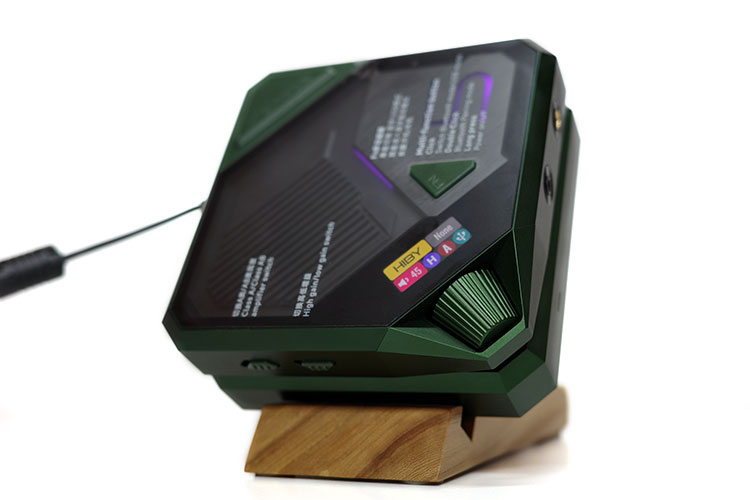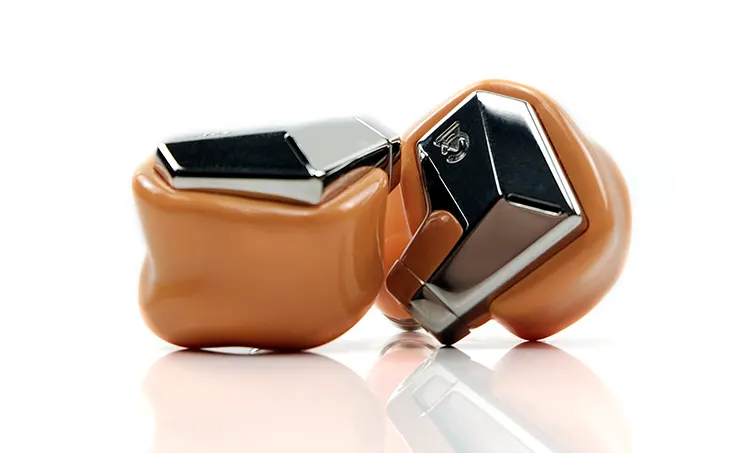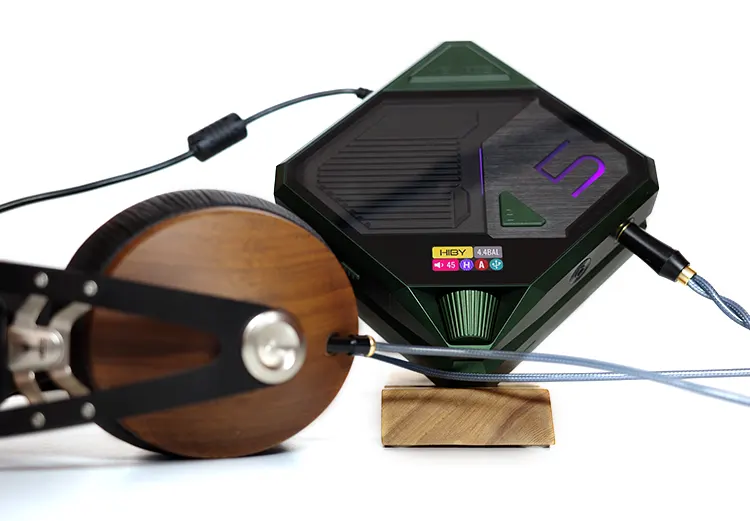Synergy
Efficiency
The FD5 carries a black background no matter the volume or gain setting. Noise between songs or softer sections within songs played without any audible hiss, even on the Campfire Audio IEMs, which traditionally show noise issues more than most.
I was able to use high gain on all of the tested units, but other than the Magni V2, it was not necessary. I could even power the Drop x Sennheiser HD6xx or FiiO FT3, which both carry 350Ω ratings. Only when I went above that did the FD5 struggle.
I did prefer low gain on IEMs and high gain on headphones, though. I never had to go much above 50 on a scale of 0-100 to attain comfortably loud listening levels on high gain.
Power
The FD5 was able to drive headphones up to 350Ω without issue. Beyond that, the FD5 cannot provide enough power to properly drive my 600Ω AKG 240DF. I expected this before the review and would not use the FD5 in such a pairing.
IEM pairings
The FD5 paired well with brighter IEMs such as the Campfire Audio Supermoon as well as darker sounds like the Spirit Torino Twin Pulse Beryllium IEM or the Solaris 2020. I can’t say I had a favorite pairing because each showed their benefits.
The Supermoon comes across as vibrantly rich in signature, with deep-reaching bass and an equally spreading up top without becoming strident.
I did find the familiar reach at the top of the Supermoon to come across a bit too sparkly for my tastes, but that happens across many sources. Pop or pieces with a vibrant sound paired especially well.
The Solaris 2020 drives lower with more gusto in the bass region, so it pairs well with bass guitar music such as Pop and EDM. Class A allowed the music to flow over the signature whereas if more accuracy was needed, Class AB sounded better.
The forward nature of the Solaris2020’s midrange added to that of the FD5 but never became shouty or too much. Male vocals come across especially well with this pairing, even if the Supermoon vocals are more accurate.
The Spirit Torino Twin Pulse IEM carries a thinner note quality to the signature than either CFA model above and with less sub-bass reach.
This is not necessarily bad, as the accuracy can come through. I found Class AB provided more accuracy to the notes, while Class A warmed the signature up lending weight to the notes.
Headphone pairings
I spent a good portion of my listening time with the Meze Audio 99 Classics hooked to the ddHiFi BC150B 4.4 cable.
The 99s are known for their accuracy of note in the sound signature, but some consider it a bit thin overall. The 4.4 balanced cable helps to spread the notes out while adding a bit of weight to the notes.
In Class A, the Meze’s simply sung with emotion to the notes, while still providing that succinctness and accuracy in character they are known for. Class AB swung the character back toward having more clarity and detail retrieval, but not too much.
This was another example where I found switching between the two even during the song was an enjoyable experience.
The Kennerton Magni V2 is known for having the traditional Kennerton forward-mid signature, with good bass and some sparkle up top to counter that along with a warmer and richer signature.
Where the Meze is accurate and detailed, the Magni is more immersive and emotive. Paired with a DHC Molecule 4.4mm balanced cable afforded a deeper reach to the bass while adding accuracy.
Running Class A, the pairing was especially good on jazz recordings and classical, while also working well with pop.
Class AB worked well with female vocal songs, and pop along with jazz again for the additional detail and clarity which came about a bit. They were the hardest to drive of any tested listening device used, though.
Powered Speakers
The Klipsch The Sixes were hooked to the FD5 using the 3.5mm LO and drove the speakers without issue.
Running both wired and BT sources through the FD5 provided excellent auditory listening, with the brighter-signature Klipsch speakers without issue. While I enjoyed the listening, I preferred using the FD5 as a strictly desktop unit for use with IEMs or headphones.
Select Comparisons
FiiO K9 AKM
Marketed as the company’s flagship AKM DAC and amplifier, the K9 AKM is equipped with a DAC combination of AK4191EQ + AK4499EX chips and a THX AAA 788+ amplifier (the same as found in the K9 Pro ESS).
For wireless capability, the K9 AKM uses a QCC5124 5.1 Bluetooth chip with LDAC and aptX Adaptive (among others) codec support. This is the same receiver you will find in the M17 too, with a similar performance level in terms of decoding.
DAC
The DAC combination is similar to others I have reviewed lately, such as the Audalytic AH90, but also incorporates DWA routing technology, which improves the S/N ratio by keeping analog & digital sound separate.
The dual clock mode XMOS U308 supports up to 768kHz-32bit/DSD512 (USB DAC) and provides a digital bridge. The addition of a USB-C input on one side also follows what the K9 Pro ESS provides the user with another connectivity option.
Amplification
The K9 AKM THX AAA 788+ amplifier provides from 780mW at 300Ω up to 2W at 32Ω balanced and from 200mW into a 300Ω load up to 1.5W into a 32Ω load unbalanced.
The slightly lower power numbers for the K9 AKM mean it may not drive demanding headphones quite as well as the K9 Pro ESS. Testing will include harder-to-drive headphones to see how well that power translates into usage, compared to the K9 Pro ESS.
Design
The K9 AKM measures 200x 224.5x 72mm (excluding foot pads), weighing in at 2.66kg with a good heft to the unit.
The footprint is on par with other reviewed desktop units but with the novelty of allowing for it to be displayed vertically as well as horizontally. It is a bit thicker than many in this range, though.
A slanted U-shaped base (padded) allows the user full access to the controls, and that slant gives an excellent look at those controls. No screen is present, but the white lettering on the black surface shows well from the desktop.
A mix of sandblasted CNC machined aluminum is used for the panels finished in black, giving the K9 AKM a more matte-like color.
Low-profile screws discreetly positioned on the rear panel hold the unit’s sleek look together, with what seems to be a sliding top chassis and a base plate attached to the front panel. The unit is prone to fingerprints, though.
Aesthetics
Identical in looks to the K9 Pro ESS, you get clean lines from front to back on the top panel and twelve panels of vents per side. The use of the vents comes in handy when propped on its side, but I did still feel some heat on the top when displayed this way.
The front panel has a large centrally positioned resistance-based potentiometer for the volume dial. Finished with a thin circular LED light behind it, that is used for color sequences indicating the current sampling rate for both wired and wireless connections, the dial also carries a lip for easy manipulation.
The edging on the K9 AKM chassis is smooth through the sides giving it a modern look to the boxy shape.
You also get protection feet for the amp which you have to apply. Inside the box, there is a strip of 3M-like wide base rubber feet that stick to the base of the K9 AKM.
I do have a couple of issues on the front, though. The first is the labeling. The white print color is a little small, which means when you are further from the display than at your desk and under dim light it is hard to read.
The second is the near-matte finished housing, which attracts fingerprints like crazy. You will need a cloth to keep this one clean.
Performance
The K9 AKM oozes an organic, natural sound, but with good detail present. Warmer and richer in sound than the FD5, the notes, while thicker, also produced good clarity. Some songs come across with crispness in sound, but this is more about the song, than that of clarity.
Headphones that carry some weight to their signature pair quite well with the sound, while IEMs will shine on the lower gain settings.
Headphones that require more power will work, however, when you move to the hardest-to-drive headphones, I wish there was more power.
For instance, the 600Ω AKG 240DF sounded good, but not great, needing an extra boost. Conversely, FiiO’s FT3 (350Ω) and ZMF’s Eikon (300Ω) sounded lively with good vibrancy.
This is a different signatures for sure, but presentations that both excelled through the K9 AKM.
The lower impedance for IEMs helped carry both the Empire Ears Legend X and Spirit Torino IEM well, allowing the individual characteristics of each model to shine through.
For not much more than the FD5, you get more input options and power with a warmer, richer tone and a thicker note weight.
Audalytic AH90
DAC
The Audalytic AH90 uses the AKM AK4499EX DAC and AK4191EQ modulator chipset just like the K9 AKM.
Utilizing a third-generation 16-core XMOS XU316 USB interface, the AH90’s USB-C decoding supports high-resolution audio streams of up to PCM 32BIT/768 kHz, native DSD512, and MQA 8x.
The AH90 is also a network streamer, currently supporting Roon Bridge (based around the Gustarender), UPnP, HQ Player, Spotify, Tidal, and Airplay through either the LAN connection or directly from the source connected.
There are no native apps though so it must be used on the source side. Settings can be tuned for the Gustarender using your PC according to some reports, (I did not modify the settings at all). There is also no app, unlike the K9 AKM.
Amplification
The output provides 1W maximum at 32Ω (from 64Ω down) through the balanced connection and 200mW at 300Ω. Not earth-shattering and less than the FD5, but it is adequate for the 4.4mm balanced port.
Power is provided through 2 OPA1612 bipolar-input opamps, using Burr Brown Texas Instrument technology.
With rail-to-rail output swings to within 600 mV on a 2-kΩ load, this increases headroom, while maximizing dynamic range. The typically smooth Burr Brown sound signature pervades the AH90 as a result.
Design
The AH90 comes in either silver or black, with a curved glass insert. To me, the silver shows the shape better, and it is easier to read the LCD and button labels.
It has a design similar to the Gustard A26 and R26 (curved glass effect) and comes across with a diminutive, thinner footprint. The unit measures 220mm x 170mm x 50mm with a minimal 2kg weight.
A large knob dominates the right side of the face, and other than the touch-sensitive on/off “button” that knob controls all features.
The use of the knob was direct and without any faults or construction snafus. The design is elegant and functional yet carries a modern look to it as well.
The AH90 can easily slip under your desktop monitor, or next to your system, minimizing its presence while doing so.
Performance
Burr Brown DACs are known for a smooth relaxing signature, and the AH90 is no different. While the sound emanating from within is indeed smooth, there is still plenty of detail wrought from the signal. This is probably the closest of the comparative models to the K9 AKM, sound-wise.
The Audalytic would not be considered a reference sound or full of detail, but neither is it a slouch where clarity and retrieval are concerned. Similar to the FD5, but richer yet.
Timbre comes across with a velvet-like smoothness in character and a distinctly warm tone. Burr Browns are typical for this sound, but without losing detail retrieval in the process.
Distinct punctuation of note treatment gives the AH90 a somewhat energetic character while keeping that smoothness.
While detail does pervade the senses, there is a certain lack of it overall due to the tuning, which hinders clarity, too. I was not left wanting for more though, as the overall signature played with that smoothness without losing grip on the intended tonality.
My Verdict
There is no denying the cyberpunk looks to the HiBy FD5. This follows on the heels of the successful R4 DAP, which shares similar design traits. The diminutive size of the FD5 dual units also makes for an interesting note.
The design and looks are all well and good, but without following that up with solid sound, the point is lost. The FD5 comes through that test very well. The ability to change between Class A and Class AB on the fly makes for a tailored signature using two very competent sound ideals.
I would have also liked more input options such as an optical connection of some sort, like the FiiO K9 AKM, which might have made this about the perfect unit.
Overall, the HiBy FD5 offers great aesthetics to go along with very competent performance. The diminutive footprint with the ability to fit into tight or small spaces simply adds to the value of the FD5 as a desktop headphone amplifier.
HiBy FD5 Technical Specifications
- DAC Section-4x AKM4493 DAC Array
- Headphone Outputs- 3.5mm TRS and CTIA-spec TRRS compatible SE headphone out, 4.4mm balanced headphone out
- LO Output Level 3.5LO-2.0Vrms(unloaded) 4.4LO- 4.0Vrms(unloaded)
- THD+N 3.5LO-0.0003% 4.4LO-0.0004%
- Noise 3.5LO-1.6μ 4.4LO-2.2μ
- SNR 3.5LO-122dB 4.4LO-126dB
- Dynamic Range 3.5LO-123dB 4.4LO-126dB
- Crosstalk Rejection 3.5LO-99dBr 4.4LO-96dBr
- Frequency Response 3.5LO-20-90kHz 4.4LO-20-90kHz
- 3.5PO Output 3.5PO(AB)-4Vrms(unloaded) 3.5PO(A)-4Vrms(unloaded)
- Output Level 3.5PO(AB)-3.9Vrms(320) 3.5PO(A)-3.9Vrms(320)
- Maximum Output Power 3.5PO(AB)-475mW 3.5PO(A)- 475mW
- THD+N 3.5PO(AB)-0.0006% 3.5PO(A)-0.0006%
- Noise 3.5PO(AB)-2.8μ 3.5PO(A)-2.8μ
- SNR 3.5PO(AB)-123dB 3.5PO(A)-123dB
- Dynamic Range 3.5PO(AB)-124dB 3.5PO(A)-124dB
- Crosstalk Rejection 3.5PO(AB)-68dBr 3.5PO(A)-68dBr
- Frequency Response 3.5PO(AB)-20-90kHz 3.5PO(A)-20-90kHz
- 4.4BAL Output 4.4BAL(AB)- 8Vrms(unloaded) 4.4BAL(A)- 8Vrms(unloaded)
- Output Level 4.4BAL(AB)- 7.0Vrms(320) 4.4BAL(A)-7.0Vrms(320)
- Maximum Output Power 4.4BAL(AB)- 1523mW 4.4BAL(A)-1523mW
- THD+N 4.4BAL(AB)- 0.0004% 4.4BAL(A)-0.0004%
- Noise 4.4BAL(AB)- 3.6μ 4.4BAL(A)-3.6μ
- SNR 4.4BAL(AB)- 125dB 4.4BAL(A)-125dB
- Dynamic Range 4.4BAL(AB)- 127dB 4.4BAL(A)-127dB
- Crosstalk Rejection 4.4BAL(AB)- 106dBr 4.4BAL(A)-106dBr
- Frequency Response 4.4BAL(AB)- 20-90kHz 4.4BAL(A)-20-90kHz
- Dimensions-115*115*52.7mm
- Display-1.1” OLED
- Weight-698g






